Published Apr 6, 2019
'The City on the Edge of Forever' is Remembered as One of Star Trek's Best
And today, the 52nd anniversary of its airing, is the perfect time to revisit this gem.

StarTrek.com
“The City on the Edge of Forever” — “City,” for short — is considered by many StarTrek fans to be the best episode of Star Trek: The Original Series and, quite possibly, the best episode of all of the Trek series (to date, anyway). That’s not surprising, since virtually every element of what makes Star Trek great can be found in “City.” It has a thought-provoking and tender story by writer Harlan Ellison, wonderful new sets by art directors Matt Jefferies and Rolland M. Brooks, terrific guest stars in Joan Collins (Edith Keeler) and John Harmon (Rodent), and outstanding acting by William Shatner, Leonard Nimoy and DeForest Kelley. Simply put, Star Trek doesn’t get much better than “The City on the Edge of Forever.”
In light of today’s 52nd anniversary of the episode's first broadcast, it seemed the perfect moment to spend some time with this classic script. Much has been said about "City" over the years, and so rather than discuss the structure of the story, or how Ellison won a Writers Guild of America Award for penning it, we've decided to take a brief look at its inanimate guest star, the Guardian of Forever, and look at one of the episode's deleted scenes.
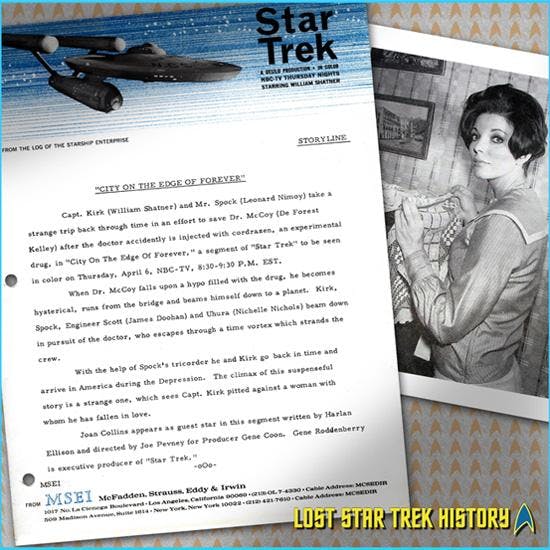
The Guardian of Forever
The Guardian of Forever features as the episode's main plot device. In Ellison’s original outline for the story, the Guardian was actually a group of robed aliens, nine-feet-tall, who referred to themselves as the Guardians of Forever. Eventually depicted on television via the TOS art and special effects departments, the Guardian became a large blue/gray translucent piece illuminated from within. It was circular in shape, reminiscent of a large analog clock face, and the TOS crew often referred to it as “the doughnut”. The Guardian’s time travel doorway — or time vortex as it’s referred to in the shooting script — was located within its center, and the script indicated that it should show, “A series of almost subliminal historical scenes… smoothed out or sometimes even obscured...”
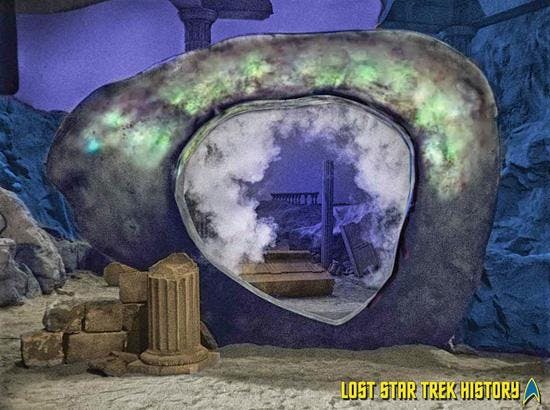

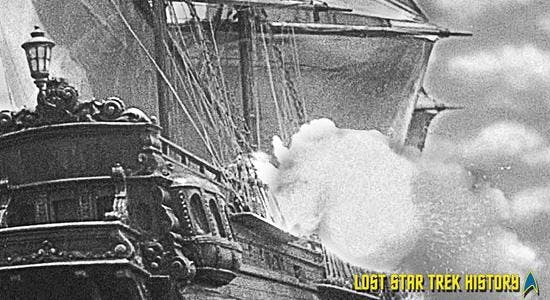
Time Jumping
McCoy, Kirk, and Spock traveled to 1930 Earth and back again by jumping into the Guardian’s time vortex. The “hole” for the vortex was designed and fabricated large enough for a couple of humans (or a human and a Vulcan) to make the trip at the same time. Jumping through was simple, as long as they didn’t bump shoulders.

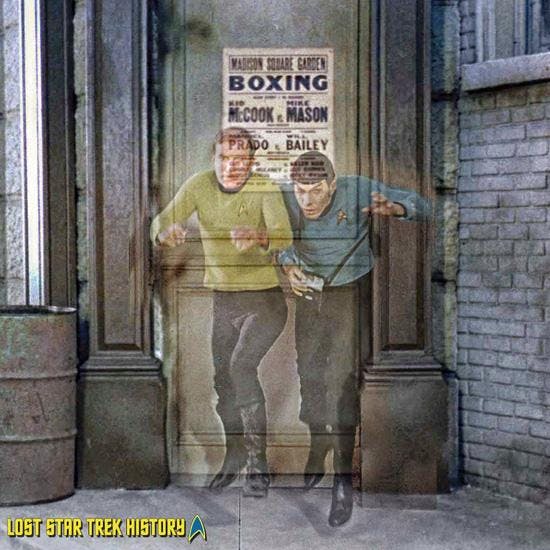
Broken Dishes – A Deleted Scene
Many scenes were filmed for “City” that, in the end, weren't used or found themselves heavily trimmed as the episode was being assembled. We’ve counted about seven of them, and that includes the wonderful scene on the Roddenberry Vault Blu-ray set that shows Kirk and Edith talking on the staircase following Edith’s accidental trip down the stairs.
One of the scenes that was removed from “City” that, as far as we know, no longer exists anywhere, showed Kirk having an accident at the 21st Street Mission as he and Edith cleaned up. This deleted scene was scripted and filmed for the middle of the third act, and it was to have occurred between the scenes of Rodent killing himself with McCoy’s phaser and Kirk and Edith talking at the top of the staircase about man reaching the moon (both of which made it to air). The photo below shows a lost scene obtained from a Lincoln Enterprises film clip, and we’ve paired it with its description from the shooting script (in italics). Please note that this scene didn’t contain dialogue.
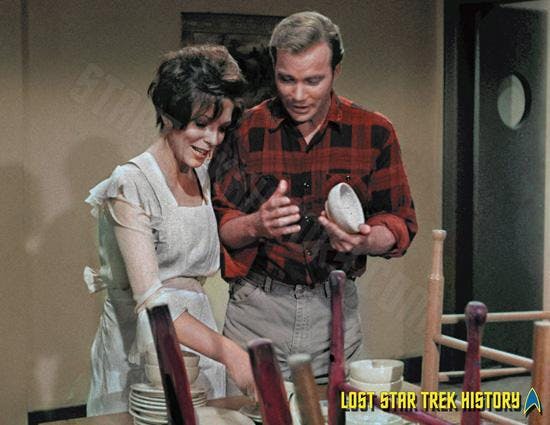
SPOCK’S P.O.V.– KIRK AND EDITH
Kirk is coming through the outside door carrying a high pile of glasses and dishes in a tub. Edith holds the door, directs him to a bench so he can put them down. She tries to reach up to take some of the load, but Kirk pulls away, not allowing her to help. However, in pulling away, he promptly manages to drop half the dishes and glasses to the floor. A nerve ripping CRASH. As he stands there, looking in disgust at the mess of broken crockery, Edith reaches up to touch his shoulder comfortingly. At her touch, Kirk’s face changes, softens… a man caught by a stir of feeling for a woman.
It’s unfortunate that this material wound up on the cutting-room floor, as it would have been fun to watch Shatner and Collins play it in the episode.
David Tilotta is a professor at North Carolina State University in Raleigh, NC and works in the areas of chemistry and sustainable materials technology. You can email David at david.tilotta@frontier.com. Curt McAloney is an accomplished graphic artist with extensive experience in multimedia, Internet and print design. He resides in a suburb of the Twin Cities in Minnesota, and can be contacted at curt@curtsmedia.com. Together, Curt and David work on startrekhistory.com. Their Star Trek work has appeared in the Star Trek Magazine and Star Trek: The Original Series 365 by Paula M. Block with Terry J. Edrmann.

